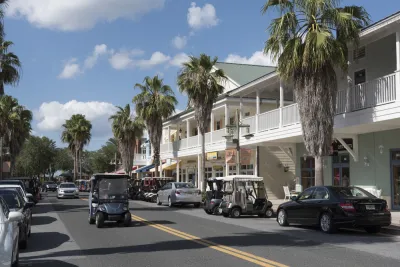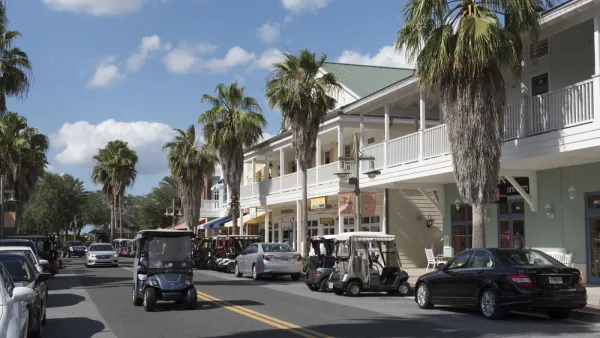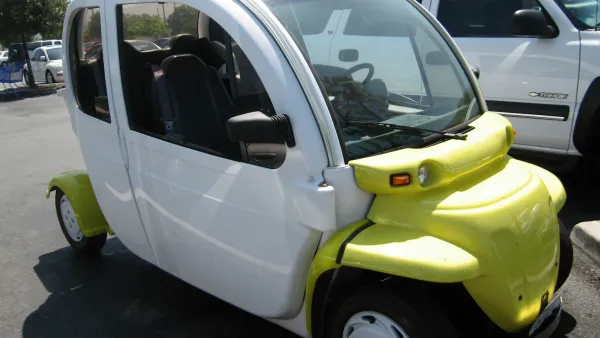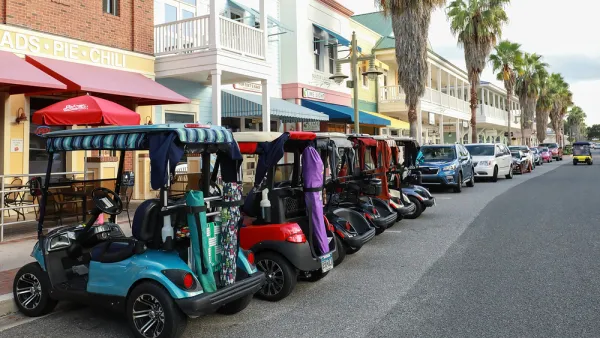Designing roads for low-speed vehicles like golf carts can make getting around safer and easier for seniors.

There is much for urbanists to critique about Florida's master-planned community the Villages–currently "the fastest-growing metropolitan statistical area in the country." But one thing the Imagineer-designed retirement community got right, argues Alissa Walker, is their enthusiastic support of golf carts as a transportation mode.
"Those golf carts, in fact, make a lot of urban-transportation planners salivate. By some estimates, one-third of all trips in the Villages are taken in them. They run on electricity, or on a little bit of non-ethanol gasoline (dispensed from old-timey pumps, even). They are lightweight and barely pollute. They’re not supposed to go faster than 20 mph, and they don’t kill many people the way cars do (although it does happen)."
Not that the Villages is any kind of car-free utopia. Ryan Erisman, author of Inside the Bubble: The Complete Guide to Florida’s Most Popular Community, says "[m]ost people still have cars" which they use for any trips outside the immediate neighborhood. Meanwhile, the Villages has no public transit to speak of. "Of course we should be working, in general, to put everything closer together so nobody has to get behind the wheel at the age of 95 — or 55, for that matter." But the concept of actively designing for golf carts or other slow-speed vehicles could go a long way toward making cities more friendly to seniors and the general population.
FULL STORY: There's One Thing We Can Learn From the Villages Success

National Parks Layoffs Will Cause Communities to Lose Billions
Thousands of essential park workers were laid off this week, just before the busy spring break season.

Retro-silient?: America’s First “Eco-burb,” The Woodlands Turns 50
A master-planned community north of Houston offers lessons on green infrastructure and resilient design, but falls short of its founder’s lofty affordability and walkability goals.

Delivering for America Plan Will Downgrade Mail Service in at Least 49.5 Percent of Zip Codes
Republican and Democrat lawmakers criticize the plan for its disproportionate negative impact on rural communities.

Test News Post 1
This is a summary

Test News Headline 46
Test for the image on the front page.

Balancing Bombs and Butterflies: How the National Guard Protects a Rare Species
The National Guard at Fort Indiantown Gap uses GIS technology and land management strategies to balance military training with conservation efforts, ensuring the survival of the rare eastern regal fritillary butterfly.
Urban Design for Planners 1: Software Tools
This six-course series explores essential urban design concepts using open source software and equips planners with the tools they need to participate fully in the urban design process.
Planning for Universal Design
Learn the tools for implementing Universal Design in planning regulations.
EMC Planning Group, Inc.
Planetizen
Planetizen
Mpact (formerly Rail~Volution)
Great Falls Development Authority, Inc.
HUDs Office of Policy Development and Research
NYU Wagner Graduate School of Public Service





























